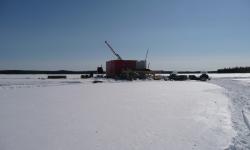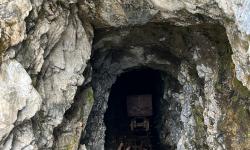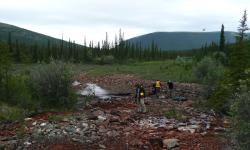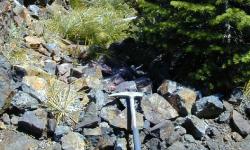Eagle Plains Stakes Terrace, BC area High-Grade Gold Occurrences
British Columbia | February 20, 2003Cranbrook, B.C.: Eagle Plains Resources Ltd. (EPL:TSX-V) has completed staking activity and received title to a 489-unit (29,700 acre) claim block located 30km northwest of Terrace, near the central coast of British Columbia. The claims cover a number of high-grade gold occurrences related to a Cretaceous-aged granitic intrusive stock with kilometer-scale dimensions. The "Kalum" project is accessed by a network of logging roads, transected by a hydro-electric power-line, and is located 90km by road from port facilities in Kitimat, or 100km by rail from Terrace to port facilities in Prince Rupert. Extensive logging activity has taken place throughout the project area, with additional road-building and logging activity planned over the next three years, as part of a development plan approved by the BC Ministry of Forests in 2000. Eagle Plains owns a 100% unencumbered interest in the project, and holds a 1% Net Smelter Return in trust for Bernard Kreft, whose extensive research of the area resulted in the recognition of its geological and potential economic significance.
The claims cover an area approximately 10km x 12km that is underlain by sedimentary rocks that have been intruded by a very large intrusive stock. Seven documented high-grade gold occurrences are located at or near the contact zone of the intrusive, while a single poorly-documented copper/molybdenum occurrence is known to exist within its core. Following is a summary of documented occurrences, with results reported directly from the BC Geological Survey’s (“BCGS”) Minfile database:
KALUM LAKE (Minfile #103I019): two intrusive-hosted veins 150m apart described as being 0.15 to 0.60m in width. Trench samples assayed up to 251g/t (grams per tonne) Au and 226 g/t Ag. (B.C. Energy Mines and Petroleum Resources "EMPR" Assessment Report (#13303). A 52.4 kg bulk sample taken from these veins assayed 11.86 g/t Au and 15.43 g/t Ag. Reserves reported for the two main veins are estimated at 9,434 tonnes grading 16.1 g/t Au to a depth of 45m. A sample taken by Eagle Plains consultants of quartz vein material returned 811.8 g/t Au, 274 g/t Ag, 1.04% Cu, and 1.17% Pb, with highly anomalous arsenic, antimony, bismuth and mercury values. This sample was re-assayed by Acme Analytical Laboratories, and returned 826.5 g/t Au.
HAT (#103I173): polymetallic vein up to 0.5m wide containing up to 41.1 g/t Au and 9,588 g/t Ag. (EMPR AR #10821)
CHRIS (#103I174): polymetallic vein 0.3 to 1.34m wide, 300m long, averaging 0.6m wide. Average chip samples over the 300m length assayed 11.25 g/t Au, 80.57 g/t Ag, and 1.4 % Pb. A second vein located 40m to the south averaged 2.09 g/t Au and 8.23 g/t Ag (EMPR AR #10523)
MARTIN (#103I020): polymetallic vein up to 0.5m wide assayed 8.2 g/t Au, 137 g/t Ag and 4% Pb over 0.3m. A second parallel vein located 50m away consists largely of massive arsenopyrite, and returned 6.8 g/t Au and 12.3 g/t Ag over 0.2m.
MISTY (#103I213): a series of intrusion-related polymetallic veins varying from 1.0 to 2.5m in width. A chip sample taken across 0.6m assayed 21.6 g/t Au. This occurrence was drilled and returned 4.7 g/t Au over 0.77m. Inconsistent correlation between surface and drill-core results were attributed to poor drill-core recoveries and the coarse nature of the gold.
QUARTZ-SILVER (#103I018): a series of sediment-hosted polymetallic veins associated with dykes and intrusive rocks assayed 78.9 g/t Ag, 7.74% Pb, 15.38% Zn and 0.34 g/t Au across a 0.60m sample width.
BURN (#103I211): intrusion-related polymetallic veins associated with intense propylitic alteration and “a high density of quartz veining and shearing”. A grab sample reported by past operators assayed up to 16.8 g/t Au and 242.1 g/t Ag.
BCGS stream-sediment surveys of creeks draining the Kalum Intrusion and sedimentary-intrusive contact area reveal the presence of highly anomalous values (many in the 95th percentile) for the elements gold, silver, arsenic, tungsten, copper, molybdenum - all considered key pathfinder elements for intrusion-related gold systems (“IRGS”). Review of existing airborne geophysical data for the area confirms the presence of a pronounced magnetic anomaly coincident with the intrusive material, and suggests the presence of a much larger system than is currently outlined. Many of the above-noted mineral occurrences are located within the halo of the magnetic anomaly, which appears to correspond with the sedimentary-intrusive contact area. These individual occurrences have been the focus of exploration efforts since the early 1900s, but were worked individually and targeted for development as low-tonnage, high-grade producers. Many high-grade veins which saw work were documented as occurring within a series of veins or within stockwork swarms. All exploration work in the project area was completed prior to the discovery and recognition of IRGS models and the development of deposits such as Kinross Gold’s Fort Knox, located near Fairbanks, Alaska (158.3 Mt grading 0.83 g/t, with a contained resource of 4.3 M oz Au) and the Pogo deposit located in the Goodpaster River area of Alaska (currently under development by TeckCominco, containing stated reserves of 10.7 Mt at an average grade of 17.82 g/t, for a contained resource of 5.6 M oz Au). Despite the strong presence of geological, geochemical and geophysical indicators of IRGS mineralization, no exploration efforts have previously been directed towards assessing the occurrences in the Kalum area for their low-grade, bulk-tonnage potential, nor has any exploration activity been documented over the roughly 25km of projected contact area. At the time of staking by Eagle Plains, all previous mineral tenures within the mapsheet had forfeited, allowing the Company the opportunity to secure the complete intrusive package including the entire contact zone.
Eagle Plains intends to complete an extensive GIS compilation of all existing data relating to the project area. Financing will be initiated to ensure that an aggressive and comprehensive field program will be completed during the 2003 field season. Work will be directed to assess the project area and identify similarities to known IRGS deposits such as Fort Knox, Pogo, Donlin Creek, Kidston, and other recently recognized deposits of this type located around the world.
Eagle Plains Resources continues to conduct research, acquisition and exploration projects in western Canada. Through a network of prospectors, consultants and experienced contractors in addition to seasoned employees and a well-rounded Board of Directors, the Company has assembled a diverse portfolio of gold and base-metal properties. EPL seeks to attract joint-venture participation on it’s properties, thereby leveraging exploration spending to the ultimate benefit of the Company’s shareholders. In recent years, Eagle Plains has completed option agreements with Billiton, Rio Algom, Kennecott, Novagold Resources, Viceroy Resources and numerous other junior exploration companies, resulting in nearly 10,000m (33,000’) of drilling and over $5,000,000 in exploration spending on its properties since 1998.
On behalf of the Board of Directors
Signed
“Tim J. Termuende”
President and CEO
For further information on EPL, please contact Mike Labach at 1 866 HUNT ORE (486 8673)
Email: mgl@eagleplains.com or visit our website at http://www.eagleplains.com
Cautionary Note Regarding Forward-Looking Statements
Neither the TSX Venture Exchange nor its Regulation Services Provider (as that term is defined in the policies of the TSX Venture Exchange) accepts responsibility for the adequacy or accuracy of this release. This news release may contain forward-looking statements including but not limited to comments regarding the timing and content of upcoming work programs, geological interpretations, receipt of property titles, potential mineral recovery processes, etc. Forward-looking statements address future events and conditions and therefore, involve inherent risks and uncertainties. Actual results may differ materially from those currently anticipated in such statements.
Related Projects
Latest News Releases

Eagle Plains Shareholders Approve all Matters at Annual General Meeting

Eagle Plains’ Partner Refined Energy Corp. Approves 2026 Drill Program for the Dufferin West Project, Saskatchewan

Eagle Plains Reports up to 29.9 g/t Au over 1.8m at the Bulldog Gold – Silver Project, Golden Triangle, BC

Eagle Plains Partner Xcite Resources Commences Airborne Geophysical Surveys at Uranium City Area Projects, Saskatchewan



